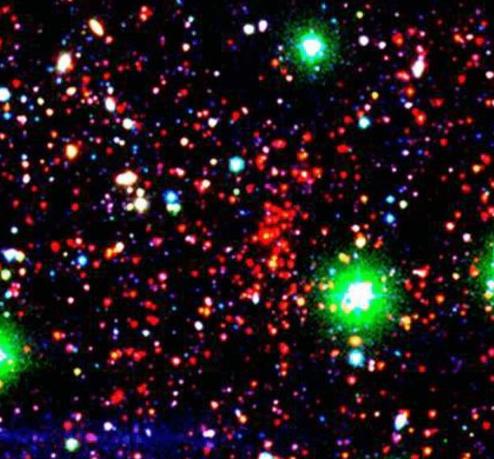Named the Spitzer Adaptation of the Red-sequence Cluster Survey, "SpARCS" detects galaxy clusters using deep ground-based optical observations from the CTIO 4m and CFHT 3.6m telescopes, combined with Spitzer Space Telescope infrared observations.
SpARCS is designed to find clusters as they appeared lwhen the universe was 6 billion years old or younger. Astronomers believe the universe was formed 13.7 billion years ago.
Clusters of galaxies are rare regions of the universe consisting of hundreds of galaxies containing trillions of stars, plus hot gas and mysterious dark matter. Most of the mass in clusters is actually in the form of invisible dark matter which astronomers are convinced exists because of its influence on the orbits of the visible galaxies.

One of the most distant galaxy clusters ever discovered. Many similar-color red cluster galaxies can be seen in the image (the green blobs are stars in our own galaxy, The Milky Way. Image credit: G. Wilson, UC Riverside, and A. Muzzin, Yale University.
An example of one of the most massive clusters found in the SpARCS survey is shown in the accompanying image. Seen when the universe was a mere 4.8 billion years old, this is also one of the most distant clusters ever discovered. Many similar-color red cluster galaxies can be seen in the image (the green blobs are stars in our own galaxy, The Milky Way).
"We are looking at massive structures very early in the universe's history," said Gillian Wilson, an associate professor of physics and astronomy who leads the SpARCS project.
The SpARCS survey has discovered about 200 new cluster candidates.
"It is very exciting to have discovered such a large sample of these rare objects," Wilson said. "Although we are catching these clusters at early times, we can tell by their red colors that many of the galaxies we are seeing are already quite old. We will be following up this new sample for years to come, to better understand how clusters and their galaxies form and evolve in the early universe."
A summary of the survey and additional images of newly discovered clusters may be found in two companion papers led by Wilson and Adam Muzzin of Yale University, published in the June 20 issue of The Astrophysical Journal.
The SpARCS team consists of Wilson, who joined UCR in 2007, Ricardo Demarco of UCR; Muzzin of Yale University, Conn.; H.K.C. Yee of the University of Toronto, Canada; Mark Lacy and Jason Surace of the Spitzer Science Center/California Institute of Technology; Henk Hoekstra of Leiden University; Michael Balogh and David Gilbank of the University of Waterloo, Canada; Kris Blindert of the Max Planck Institute for Astronomy, Germany; Subhabrata Majumdar of the Tata Institute of Fundamental Research, India; Jonathan P. Gardner of the Goddard Space Flight Center; Mike Gladders of the University of Chicago; and Carol Lonsdale of the North American ALMA Science Center; Douglas Burke of the Harvard-Smithsonian Center for Astrophysics; Shelly Bursick of the University of Arkansas; Michelle Doherty, Chris Lidman and Piero Rosati of ESO; Erica Ellingson of the University of Colorado; Amalia Hicks of Michigan State University; Alessandro Rettura of Johns Hopkins University; David Shupe of the Herscel Science Center/California Institute of Technology; Paolo Tozzi of the University of Trieste, Italy; Renbin Yan of the University of Toronto; and Tracy Webb of McGill University, Canada.
This work is based in part on archival data obtained with the Spitzer Space Telescope, which is operated by the Jet Propulsion Laboratory, California Institute of Technology under a contract with NASA. This work is also based on observations obtained with The Cerro Tololo Inter-American Observatory, which is operated by the Association of Universities for Research in Astronomy, under contract with the National Science Foundation; observations obtained with MegaPrime/MegaCam, a joint project of CFHT and CEA/DAPNIA, at the Canada France-Hawaii Telescope (CFHT), which is operated by the National Research Council (NRC) of Canada, the Institut National des Sciences de l'Univers of the Centre National de la Recherche Scientifique (CNRS) of France, and the University of Hawaii; and by observations obtained at the Gemini Observatory, which is operated by the Association of Universities for Research in Astronomy, Inc., under a cooperative agreement with the NSF on behalf of the Gemini partnership: the National Science Foundation (United States), the Science and Technology Facilities Council (United Kingdom), the National Research Council (Canada), CONICYT (Chile), the Australian Research Council (Australia), Ministério da Ciência e Tecnologia (Brazil) and SECYT (Argentina).
Support for this work was provided, in part, by awards issued by JPL/Caltech, and from Wilson's College of Natural and Agricultural Sciences start-up funds at UCR.





Comments